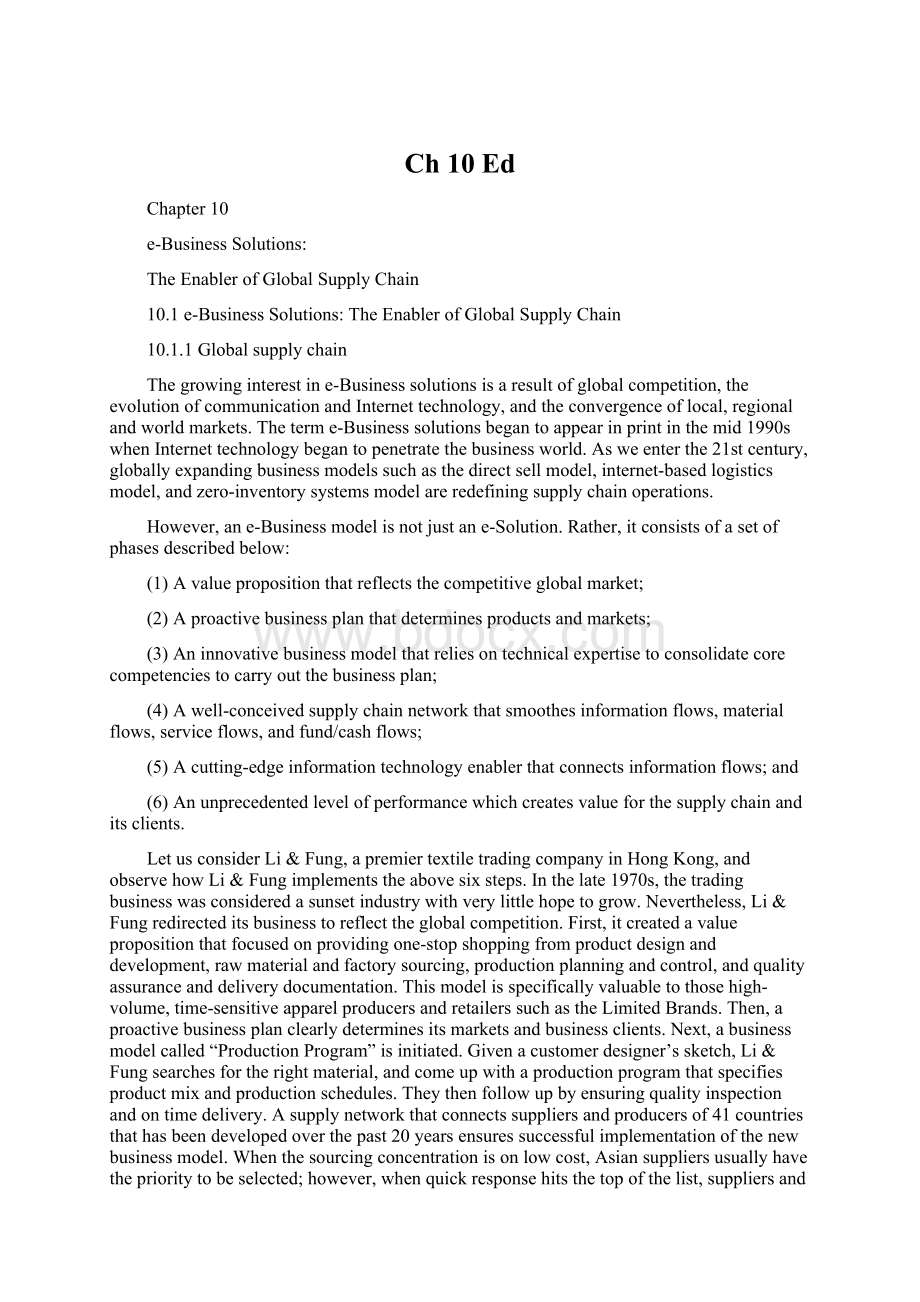Ch 10 Ed.docx
《Ch 10 Ed.docx》由会员分享,可在线阅读,更多相关《Ch 10 Ed.docx(15页珍藏版)》请在冰豆网上搜索。

Ch10Ed
Chapter10
e-BusinessSolutions:
TheEnablerofGlobalSupplyChain
10.1e-BusinessSolutions:
TheEnablerofGlobalSupplyChain
10.1.1Globalsupplychain
Thegrowinginterestine-Businesssolutionsisaresultofglobalcompetition,theevolutionofcommunicationandInternettechnology,andtheconvergenceoflocal,regionalandworldmarkets.Theterme-Businesssolutionsbegantoappearinprintinthemid1990swhenInternettechnologybegantopenetratethebusinessworld.Asweenterthe21stcentury,globallyexpandingbusinessmodelssuchasthedirectsellmodel,internet-basedlogisticsmodel,andzero-inventorysystemsmodelareredefiningsupplychainoperations.
However,ane-Businessmodelisnotjustane-Solution.Rather,itconsistsofasetofphasesdescribedbelow:
(1)Avaluepropositionthatreflectsthecompetitiveglobalmarket;
(2)Aproactivebusinessplanthatdeterminesproductsandmarkets;
(3)Aninnovativebusinessmodelthatreliesontechnicalexpertisetoconsolidatecorecompetenciestocarryoutthebusinessplan;
(4)Awell-conceivedsupplychainnetworkthatsmoothesinformationflows,materialflows,serviceflows,andfund/cashflows;
(5)Acutting-edgeinformationtechnologyenablerthatconnectsinformationflows;and
(6)Anunprecedentedlevelofperformancewhichcreatesvalueforthesupplychainanditsclients.
LetusconsiderLi&Fung,apremiertextiletradingcompanyinHongKong,andobservehowLi&Fungimplementstheabovesixsteps.Inthelate1970s,thetradingbusinesswasconsideredasunsetindustrywithverylittlehopetogrow.Nevertheless,Li&Fungredirecteditsbusinesstoreflecttheglobalcompetition.First,itcreatedavaluepropositionthatfocusedonprovidingone-stopshoppingfromproductdesignanddevelopment,rawmaterialandfactorysourcing,productionplanningandcontrol,andqualityassuranceanddeliverydocumentation.Thismodelisspecificallyvaluabletothosehigh-volume,time-sensitiveapparelproducersandretailerssuchastheLimitedBrands.Then,aproactivebusinessplanclearlydeterminesitsmarketsandbusinessclients.Next,abusinessmodelcalled“ProductionProgram”isinitiated.Givenacustomerdesigner’ssketch,Li&Fungsearchesfortherightmaterial,andcomeupwithaproductionprogramthatspecifiesproductmixandproductionschedules.Theythenfollowupbyensuringqualityinspectionandontimedelivery.Asupplynetworkthatconnectssuppliersandproducersof41countriesthathasbeendevelopedoverthepast20yearsensuressuccessfulimplementationofthenewbusinessmodel.Whenthesourcingconcentrationisonlowcost,Asiansuppliersusuallyhavetheprioritytobeselected;however,whenquickresponsehitsthetopofthelist,suppliersandproducersinEasternEurope,theMediterranean,andSouthAmericawillbecontractedtomeetthedeliveryrequirementsinthesameregion.Withsuchanexpandednetwork,informationtechnologybecomesaninevitableenablerforLi&Fungtoeffectivelycommunicateacross74officesin41countries.E-Solutionssuchasemail,fax,EDI,website,ande-Hubconnectitsworldwidesupplynetwork.By2004,Li&Funggeneratedannualrevenueof$7billionandhad18,000employeesaroundworld.
10.1.2e-Solutionoutsourcing:
Aperceivabletrend
Asbusinessesspreadoutovertheworld,IToutsourcingbecomesagoldenopportunityformanycorporationstogeneratehighrevenues.TheIToutsourcingmodelhasbeenadoptedbyatleast40%ofFortune500companies.CorporationssuchasMicrosoft,Lucent,DellInc.,WellsFargo,andMotorolaallhaveoffshoredivisions.AshortageofITsoftwaredevelopmentskills,reductionindirectandindirectcosts,anddecreasesindeliveryleadtimebroughtmajorchangesinITsourcingarrangements.Additionally,offshoreofficesenable“follow-the-sun”officehours.WhenaUSteamfinishesaneight-hourworkday,theIndianofficewillpickuptheduty.
Startingin2001,DellInc.openedtechnicalsupportcentersforU.S.consumersandcustomersaroundtheworld.In2006,DellIndiawasabletoexpandoperationstoincludesalescenters.Dell’stwoIndiaservicecenters,HyderabadandBangalore,haveover6,000staffmembers.NowDellIndianotonlyfocusesoncustomerservicecallsbutalsoworksonproductdevelopmentandtesting.
However,thereisadownsideassociatedwithoffshoreservicecenters.SomeseriouscomplaintsaboutDell’soffshorecallcenterhasforcedDelltostoproutingtechnicalinquiriesfromsomecorporatecustomerstoitsoverseasofficesduetocomplaintsaboutthepoorqualityofitsoffshorecenters.
10.2EnterpriseInformationSystems
AnEnterpriseInformationSystem(EIS)isanintegratedinformationtechnologyforstreamliningbusinessprocesses;itisabletofacilitatetheflowofdataandinformationamongallsupplychainprocessesofafirmandamongtradingpartners.WikipediaEncyclopediadescribesEISasfollows:
EnterpriseInformationSystemsprovideatechnologyplatformthatenableorganizationstointegrateandcoordinatetheirbusinessprocesses.Theyprovideasinglesystemthatiscentraltotheorganizationandensurethatinformationcanbesharedacrossallfunctionallevelsandmanagementhierarchies.Enterprisesystemsareinvaluableineliminatingtheproblemofinformationfragmentationcausedbymultipleinformationsystemsinanorganization,bycreatingastandarddatastructure.
AnEISformallycalledERP(enterpriseresourceplanningsystems)isasystemforasingleenterpriseorcompany,attemptingtointegratemostofthebusinessactivitieswithinthecompany.Oneenterprisecanbeinvolvedwithonesupplychainorwithanumberofsupplychainsfordifferentproductlinesandmarkets.ManycompanieshavebeguntorecognizeEIS’potentialtocreateabroadersourceofcompetitiveadvantage,andhavecapitalizedontheincreasinglycross-functionalspanofthetechnology.
EISsystemexpenditureswereamongstthelargestITinvestmentsofthe1990s.EISsystemshavebeenimplementedinover60%ofmulti-nationalfirms.Thelicense/maintenancerevenueoftheEISmarketwas$17.2billionin1998.EvenmajorUSsoftwarecompanieshaveadoptedEISproducts.Forexample,IBMandMicrosoftnowrunmostoftheirbusinessonSAPR/3ERsoftware.Thedatareleasedinthefourthquarterof2000indicatesthattheworldwideEISmarketwillgrowatarateof24.9%andreach$73billionin2004.Recently,EISisbecomingpopularinthesmallandmediumenterprisemarketsegmentduetothesuddenimportanceofCustomerRelationshipManagement(CRM),supplychainmanagement,andbusinesstocustomer(B2C)commerceinthebusinessenvironment.
10.2.1Businessprocessreengineering–ThefoundationforimplementingEIS
Itisnotthefirsttimeinhistorythattechnologyhasreshapedanexistingbusinessprocess.Inthe1920s,FordMotorproductionsystemutilizedassemblylinetechnologytospeedupproductivityandrealizeeconomiesofscale.Thistechnologyalteredtheentireautomobileproductionprocess.Today,computerandinformationtechnologyhavecreatedanewwayofdoingbusiness,whichrequiresorganizationstore-thinkandre-structuretheirbusinessprocess.Thisinitiativeiscalledbusinessprocessre-engineering.
Businessprocessre-engineeringisamethodbywhichanorganizationexaminesandredesignsitsbusinessprocessesinaccordancewithitsstrategicobjectivesofimplementingenterpriseinformationsystems.
EISisaprocessorientede-Businesssolutionthatkeepstrackofpurchasing,businesstransactions,orderfulfillment,andproductionplanningandcontrolactivities.Consequently,onebusinessprocessissueoftenhasrepercussionsandeffectsonanotherprocessissue.EverycompanythathasimplementedanEISsystemisfacedwithreengineeringitsexistingwayofdoingbusiness.
TosuccessfullyimplementEISsystems,anorganizationneedstoanalyzeitsbusinessprocessandproduceabusinessblueprint.Processreengineeringincludesrevisingpoliciesandproceduresabusinessusestorunoperations.Sincethesoftwaredoesnotallowpeopletodothingstheoldway,thereengineeredprocessbecomestheonlywaythatpeoplecanwork.ImplementingEISrequirestwokeyaspectsofprocessreengineering.First,businessprocessesshouldbeplacedinthecenteroforganizationalstructureratherthanbeingtreatedasindividualfunctions;andsecond,businessactivitiesshouldnotbedividedaccordingtotheconceptofspecializationorthedivisionoflabor.Rather,thecompleteprocessshouldbesystematicallyoptimizedinanenterprise-widesetting.
10.2.2Legacysystems
Legacysystemisaverybroadlabelandappliestoawidevarietyofsystemswithapplicationsthatcanrangefromorderentrytomanufacturingschedulingtoorderdelivery.Before1990s,legacysystemwasapopulartechnologysolutiontohandlebusinesstransactions.Duringthe1990s,EISsystemsbecameareplacementforlegacysystemsformanyFortune500companies.Twoimportantcharacteristicsoflegacysystemsare(i)narrowscopeandvisibility;and(ii)convenientatperformingoperationaltasks.
Theadvantagesoflegacysystemsinclude:
∙Abilitytoaccomplishoperationswithoutadditionalsupportsuchasprocessreengineeringandusertrainingexpense;and
∙Incrementalfeaturesarelessexpensivetoinstallcomparedtoaclient/serversystem.
Thedisadvantagesoflegacysystemsinclude:
∙Limitedfocus;onlyasmallpartofafirmorasupplychain’soperationscanbehandled;
∙Transactionalcapabilityonly;and
∙Lessflexibletobemodifiedduetomainframetechnology.
Asaresultofitsnarrowapplicationscope,legacysystemlostitsappealwhenclient/servertechnologywasintroducedtothemarketint